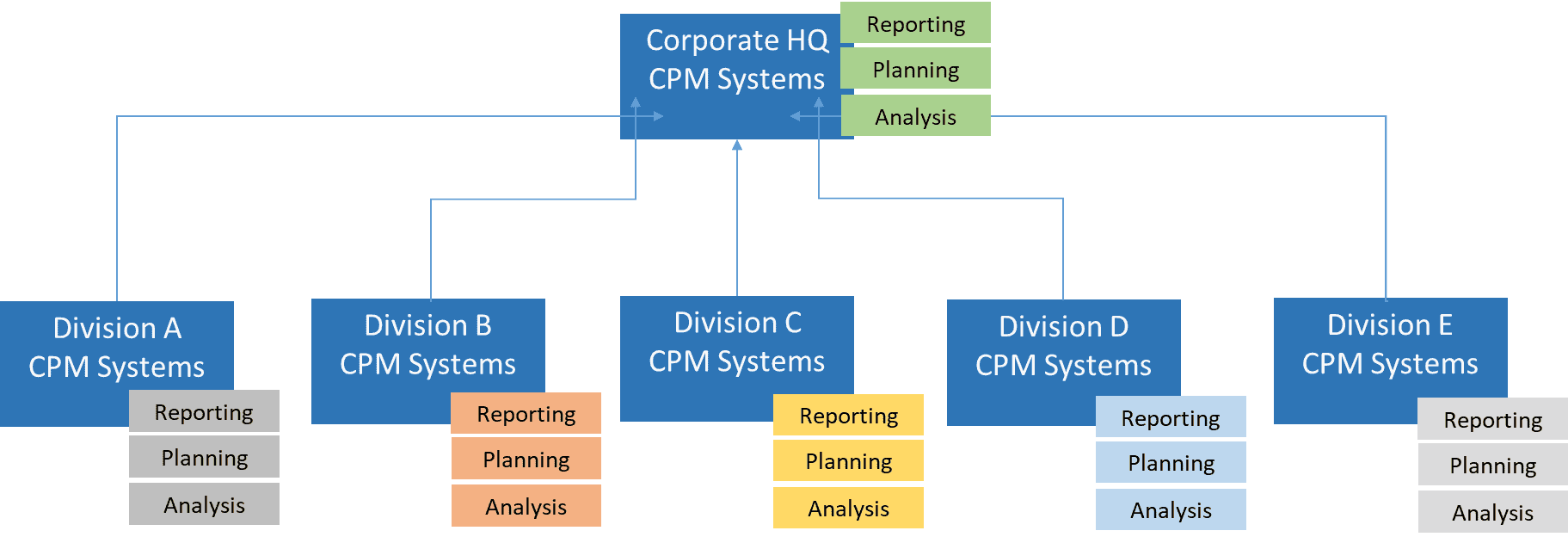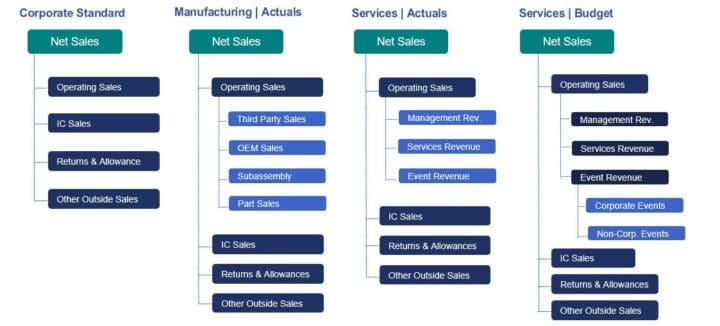Corporate performance management (CPM) is an enterprise-wide process that helps organizations meet their financial goals by linking their strategies to plans and execution across all divisions and departments. A unified, extensible CPM system software platform is essential to efficiently and cost-effectively delivering on this vision while supporting timely and informed decision-making.
Conversely, fragmented software approaches to CPM introduce risks, require manual data movement and multiple points of maintenance, and drive a high cost of ownership.
The Issues with Fragmented Systems
CPM software solutions are typically purchased, set up and rolled out from the corporate Finance organization for planning, budgeting, forecasting, reporting and other analytical use cases. The meta data structures defined in the CPM applications (e.g., chart of accounts, organizational hierarchies) are usually based on corporate financial and management reporting requirements.
However, as the solution is rolled out and deployed at line-of-business levels, cases often exist where divisions, business units and departments need to plan and report at a lower level of detail vs. corporate. How is this handled?
Several traditional approaches are used to handle the more detailed needs for line-of-business planning and reporting that aren’t accommodated by the corporate CPM system:
- Spreadsheets – Business units often handle their operational planning and reporting in spreadsheets that include the additional level of detail needed. Then they summarize the data and load it into the corporate CPM application. This is a low-cost solution to the problem, but it requires a lot of manual data collection and manipulation. It’s also prone to errors.
- Point software solutions – In some cases, subsidiaries and business units of larger enterprises purchase their own CPM applications for planning and reporting, then deploy them to support their specific requirements. They will then extract summarized data from the point solution and enter, or load, this into the corporate CPM system. This approach provides more control than using spreadsheets, but still requires manual data manipulation to meet corporate reporting and planning requirements.
- Separate instances of the corporate CPM applications/suites – Larger enterprises will often implement multiple instances of the corporate CPM applications or suites. Legacy CPM application suites themselves suffer from fragmentation and the need to move data between them. These additional instances are required to capture the level of detail needed to support operational planning and reporting requirements. Then a summarized view of this data is exported and loaded into the corporate CPM applications.

While each of these approaches has pros and cons, they all suffer from a huge drawback. When corporate Finance staff are reviewing consolidated financial results or plans, they have no visibility into the underlying operational details they often need to understand budget assumptions – or the reasons for various trends in actual financial results.
A Better Approach – An Extensible CPM Platform
So what’s the alternative to using spreadsheets, point solutions or separate instances of CPM applications mentioned above? The answer – a single, centralized CPM platform that supports the collection and consolidation of financial results, but also supports more detailed management reporting, financial and operational planning, budgeting, and forecasting.
In other words, a platform that supports and enforces corporate standards and controls, but also supports the more detailed requirements of operating units.
Sounds good, right – but how is this possible? The key to achieving this is “extensibility.” What do I mean by extensibility? It’s the measure of the customer’s ability to extend a system to address additional, unique requirements vs. what was initially configured. It’s not utilizing “smart lists” or “alternate roll-ups” as with some systems. It’s not a workaround. Instead, it should be part of the platform’s original design – things you configured for one purpose can be used for other purposes.
For example – you initially configure the system to handle the collection, consolidation and reporting of corporate financial results. Then you extend the system to support the creation of budgets and forecasts that may have different workflows, different frequencies and additional levels of detail – in the accounts dimension, in the location dimension or in the products dimension.
Extensibility – The Secret Sauce in OneStream
Extensibility is the essence of OneStream’s Intelligent Finance platform. It’s the “secret sauce” that allows customers to replace multiple legacy CPM applications with a single, unified platform. Deployed via the Microsoft Azure cloud, OneStream is the first and only solution that delivers corporate standards and controls, with the flexibility for business units to report and plan at additional levels of detail without impacting corporate standards – all through a single application. We call this unique capability Extensible Dimensionality®.
Let’s look at an example using the chart of accounts dimension. In the example below (See Figure 2), Corporate has defined four accounts that roll into the Net Sales Account:
- Operating Sales, IC Sales, Returns and Allowances and Other Outside Sales
However, the Manufacturing division needs to track Operating Sales at a lower level of detail. Here’s what they’re tracking:
- Third-Party Sales, OEM Sales, Subassembly and Parts Sales
And the Services division tracks Operating Sales differently. They track the following:
- Management Revenue, Services Revenue and Event Revenue
In addition, for budgeting purposes, the Services division breaks down Event Revenue into Corporate Events and Non-Corporate Events.

Figure 2 – Different dimensional requirements across business units
With the Extensible Dimensionality® feature of OneStream, all of this can be accommodated in a single application. While the Operating Sales account is a “base account” at Corporate, this becomes a “parent account” at the division levels, with more detailed base accounts rolling into it. In OneStream, you create the Operating Sales account once, then use it in different ways across the application.
Moreover, reports, rules and security related to the Operating Sales account don’t need to be re-created or modified. Because the corporate standard chart of accounts and dimensions are shared as business users extend these dimensions for their unique needs, these dimensions always roll up to the standard. This alleviates the need for offline spreadsheets, point solutions for business units or multiple instances of a CPM application across business units.
It also means that there’s never a need to integrate, validate, or reconcile data or metadata between products or applications to compare actual vs. budget (or whatever the extended dimension). This greatly reduces complexities of a CPM implementation and deployment while delivering a system that’s easier to learn, use and maintain.
This is a unique advantage of OneStream, one that enables it to handle the requirements of large, global enterprises in a single application – often replacing multiple instances of legacy systems, point solutions and spreadsheets.
Learn More
Extensible Dimensionality is only one example of the extensibility of OneStream. The platform also supports extensibility in cubes and workflows. The platform can also be extended by downloading additional OneStream-built solutions from the Solution Exchange such as Account Reconciliations, People Planning and partner-built solutions in our PartnerPlace. Our implementations are also extensible, where each phase builds on work accomplished in previous phases and gets accelerated thanks to reusing previous work.
The power of an extensible Intelligent Finance Platform like OneStream is clear. Customers are eliminating spreadsheets, point solutions and multiple instances of legacy applications across multiple business units – reducing technical debt and streamlining key financial processes. They’re replacing them with a single, centralized CPM solution that can support corporate standards – with the ability to extend the solution to address the more detailed planning and reporting requirements of line-of-business operations.
To learn more, download and read our brochure titled An Intelligent Finance Platform for the Modern Enterprise.
Download the BrochureGet Started With a Personal Demo


